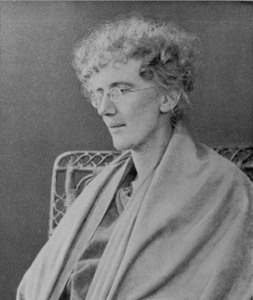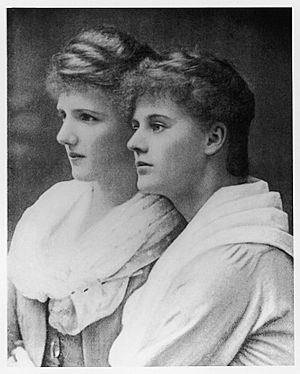Eva Gore-Booth facts for kids
Quick facts for kids
Eva Gore-Booth
|
|
|---|---|
 |
|
| Born |
Eva Selina Laura Gore-Booth
22 May 1870 County Sligo, Ireland
|
| Died | 30 June 1926 (aged 56) Hampstead, London, England
|
| Resting place | St John-at-Hampstead |
| Nationality | Irish |
| Occupation | Poet, dramatist |
| Partner(s) | Esther Roper |
Eva Selina Laura Gore-Booth (born May 22, 1870 – died June 30, 1926) was an Irish poet and writer. She was also a strong supporter of women's right to vote, a social worker, and an activist for workers' rights. Eva was born at Lissadell House in County Sligo, Ireland. Her older sister was Constance Markievicz, who later became famous as the Countess Markievicz.
Contents
Eva's Early Life and Family
Eva Selina Laura Gore-Booth was born in County Sligo, Ireland. Her parents were Sir Henry and Lady Georgina Gore-Booth of Lissadell. She was the third of five children. Eva was the first of her siblings to be born at Lissadell House.
Eva and her siblings, Josslyn, Constance, Mabel, and Mordaunt, were the third generation of their family to live at Lissadell. The house was built for her grandfather, Sir Robert Gore-Booth, 4th Baronet, between 1830 and 1835.
Both Eva and Constance were taught at home by governesses. One governess, Miss Noel, recorded many details about Eva's early life. Eva learned French, German, Latin, and Greek. She also developed a deep love for poetry, which her grandmother encouraged.
Eva was very concerned about the difference between her family's wealthy life and the poverty around them. This was especially true during the winter of the Irish Famine (1879). During this time, hungry tenants would come to their house asking for food and clothes. Esther Roper, Eva's lifelong companion, later said that Eva felt a strong responsibility for the world's unfairness.
Eva's father was an explorer. While he was away, her mother, Lady Georgina, started a needlework school for women at Lissadell. The women learned skills like crochet and embroidery. Selling their work allowed them to earn money. This project greatly influenced Eva's later work for women's rights and trade unions.
In 1894, Eva traveled with her father around North America and the West Indies. She wrote diaries about their journeys. After returning to Ireland, she met the poet W.B. Yeats. The next year, she traveled through Europe with her mother, sister Constance, and a friend. While in Venice, she became ill with a breathing problem.
In 1896, while recovering in Italy, she met Esther Roper. Esther would become her close friend and partner for life. Esther was also the secretary of the North of England Society for Women's Suffrage. Eva and Esther decided to live in Manchester. There, they worked to help working women.
Fighting for Women's Rights
Eva Gore-Booth and Esther Roper played a key role in connecting the fight for women's rights in factories with the fight for women's right to vote. Eva was a middle-class suffragist who worked mainly in the cotton towns of Lancashire from 1899 to 1913.
Eva became a member of the executive committee of the National Union of Women's Suffrage Societies. She also became a co-secretary of the Manchester and Salford Women's Trade Union Council.
In 1902, Eva Gore-Booth campaigned for David Shackleton, a Labour candidate. He promised to support women's right to vote. Shackleton was elected, but he did not keep his promise. This led Eva, Esther Roper, and Sarah Reddish to create the Lancashire and Cheshire Women Textile and Other Worker's Representation Committee.
Through this committee, Eva Gore-Booth met Christabel Pankhurst, who also strongly believed in women's rights. However, in 1904, Christabel tried to make women's suffrage a main goal of the Women's Trade Union Council. When they refused, Eva Gore-Booth resigned from the council.
Eva Gore-Booth, along with Sarah Dickenson, then started the Manchester and Salford Women's Trade and Labour Council. As part of this council, Eva and other suffragists used peaceful methods to campaign. In the 1906 general election, they put forward their own candidate, Thorley Smith, but he lost.
In May 1906, Eva was part of a group of suffragists who met with Henry Campbell-Bannerman. She felt helpless after this meeting failed. She wrote two poems, 'Women's Trades on the Embankment' and 'A Lost Opportunity', to express her feelings.
In 1907, Eva wrote an essay called "The Women's Suffrage Movement Among Trade Unionists." In it, she explained why the LCWTOW campaigned for working women to get the vote.
In 1908, Eva went to the Labour Party Conference in Hull. She suggested a motion to support women's suffrage. But this motion was defeated. Instead, a motion for adult suffrage (meaning everyone, men and women, should vote) was passed.
At the end of 1909, Eva Gore-Booth helped run a campaign in Rossendale Valley. They put forward another candidate, but he was also defeated. In 1910, Eva supported the New Constitutional Society For Women's Suffrage. In 1911, she attended a meeting in London with Esther Roper. On November 17, 1911, Eva was part of a group representing working women from northern England. They asked David Lloyd George not to drop the Conciliation Bill, which aimed to give some women the vote.
In 1911, Eva also worked for a short time as a pit-brow lass. She wanted to experience the working conditions for herself. When World War I began, Eva and Esther helped German women and children living in England. In December 1913, Eva signed the "Open Christmas Letter" to women in Germany and Austria, calling for peace. In 1915, Eva Gore-Booth joined the The Women's Peace Crusade. In 1916, she joined the No-Conscription Fellowship, which opposed forcing people into the army.
Eva Gore-Booth continued to work for peace. She wrote poetry and contributed to a private journal called Urania for the rest of her life.
Eva's Poetry and Writings
When Eva started her writing career, W.B. Yeats visited her. He was very impressed with her work. Yeats hoped she would write Irish stories that were fun and magical. Instead, Eva used Irish folklore but focused on the female characters. For example, in her story of Deirdre, she changed the usual heroic tales of Ireland to highlight women.
In her early poems, she used similar writing styles as male poets. But she wrote love poems from one woman to another, not from a male point of view.
Eva Gore-Booth was also one of the editors of the magazine Urania. This magazine was published three times a year from 1916 to 1940. It was a feminist magazine that shared stories and poems from around the world. It also included editorial comments. Many important authors, like Mona Caird, were involved with Urania.
The magazine discussed topics like gender equality, women's right to vote, and marriage. Eva Gore-Booth went even further, writing poetry about deep bonds between women. The magazine's title, Urania, can mean "heavenly" or refer to a spiritual kind of love. Eva and Esther allowed their names to be used with the magazine. Eva was seen as an inspiration for Urania.
Later Life and Legacy
Meeting political activist Esther Roper in Italy in 1896 was a turning point for Eva. Eva was there to recover from breathing problems. The two women formed a strong connection. They became partners in their personal lives and in their work until Eva's death in 1926.
Eva wrote poems dedicated to Esther, showing their deep bond. One of these poems, "The Travellers, To E.G.R," was published by Esther in 1929. In it, Eva used music and song to describe how much Esther's personality affected her.
After years of leading the Women's Suffrage Movement and fighting for women's equality, Eva and Esther moved to London in 1913. This was because Eva's breathing health was getting worse. During World War I, Eva and Esther were active in the British Peace Movement. They worked with other suffragists like Sylvia Pankhurst.
At the Women's International Congress in The Hague in 1915, Eva helped write an open Christmas letter. It was called "To the Women of Germany & Austria." It asked women to "join hands with the women of neutral countries, and urge our rulers to stay further bloodshed." It appealed to a sense of sisterhood to stop the war.
Just weeks after the Easter Rising in 1916, Eva traveled to Dublin with Esther. She played a key role in trying to save her sister Constance Markievicz from the death penalty. Constance had been sentenced to death for her part in the 1916 Rising. Eva's efforts were successful, and the sentence was changed to life in prison.
Eva's poetry from this time shows the sadness and horror she felt after visiting her sister in prison. She also campaigned to end the death penalty completely and to improve prison conditions. She attended the trial of Irish nationalist and poet Roger Casement to show her support.
Eva Gore-Booth died from cancer on June 30, 1926. In her last years, she continued to write poetry and paint. She also studied Greek and supported animal welfare. She became a Theosophist, which is a spiritual philosophy, and an animal rights activist. Eva died in her home in Hampstead, London, where she lived with Esther. She was buried next to Esther Roper in St John's churchyard, Hampstead. Her tombstone reads "Life that is Love is God."
After being told she was close to death in 1896, Eva went to the home of George MacDonald in Bordighera, Italy, to get better. There, she met Esther Roper, who was also recovering from illness. They formed a strong bond and became partners in life and work. After their time together, Eva chose to leave her privileged life in Ireland and move to Manchester. There, she bought property with Esther and became her partner in her suffrage work. Four years after they met, Eva made Esther the only person to inherit her estate.
Both Eva and Esther worked with a team to create and edit Urania. The journal was mostly sent privately around the world. But it was sent for free to anyone who asked for it. This helped create a network of supporters. Eva was seen as the leader and founder of this journal. It connected to her spiritual and feminist beliefs.
Urania tracked birth and marriage rates worldwide and celebrated when they fell. It also promoted the idea of deep, spiritual bonds between women. Eva was mentioned in Urania as an inspiration, and her words and poetry were quoted long after her death.
Eva Gore-Booth has been honored for her work by the LGBT community. An award in her honor is given at the Dublin Gay Theatre Festival. The Irish Congress of Trade Unions has also recognized Eva as an LGBT and Worker's Rights role model.
Posthumous recognition
Eva Gore-Booth's name and picture are on the plinth (base) of the statue of Millicent Fawcett in Parliament Square, London. This statue, which honors women's suffrage supporters, was unveiled in 2018.
See also
 In Spanish: Eva Gore-Booth para niños
In Spanish: Eva Gore-Booth para niños


